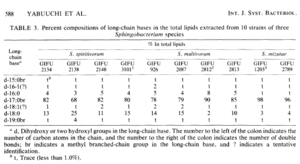Sphingobacterium multivorum
Findings
There have been three published accounts of Spingobacterium multivorum. The first account, in 1987, published from France in a man with Immunoblastomic-type non-Hodgkin’s lymphoma. A combination of antibiotic testing, carbon substrate assimilation testing and fatty acid analysis confirmed it was S. multivorum. The second patient died suffering primary peritonitis and septicemia (5). The second account, in 2006, diagnosed S. multivorum bacteria along with a couple other bacteria, claiming it was the causative agent of cyctic fibrosis in lungs. (3) The next document of the microbe The third publishing was by MD/PhD, Yaabuchi who characterized the microbe and made available his publishing. (1)
Characteristics
Laboratory tests conducted demonstrate Spingobacterium multivorum is a rod shaped non-spore forming bacteria. It also has evidence towards aerobic metabolism, using a multitude of sugars and the ability to reduce nitrogen to nitrogen gas.(1) Spingobacterium multivorum got its genus for the high composition of sphingolipid. The species name breaks down into multi: many and vorare: to swallow. (2)
Laboratory Test Results The gram stain was negative, a red-pink color, showing S. multivorum has a thinner peptidoglycan wall. The optimal growth temperature was 26 ˚C. Bacterium S. multivorum showed no evidence of sliding motility, although the other bacteria in the genus, Sphingobacterium, show sliding motility. It grew on MacConkey agar and on horse blood agar. Results from Yaabuchi show oxidative activity from a variety of carbohydrates. Additionally, S. multivorum is positive for DNase and Urease activity along with other findings listed in the table of Phenotypic characteristics published by Yaabuchi.(1) Studies of the bacteria’s nucleic information demonstrated similar homology between the 5 strains of S. multivorum, shown in Yaabuchi’s dendogram, noted as the cluster B-3. Moreover, Yaabuchi compared Spingobacterium to Flavobacterium showing a greater ‘G+C’ content in the Spingobacterium, which proves better DNA stability, because of the higher hydrogen bonding of the nucleotide pairs. Another laboratory test explaining % of total lipids of long chain lipids analyzed by thin layer chromatography and extracted by saponification. The bacterium was also tested for drug resistance, showing the results in the figures. (1)
Further Testing Required
Due to the novelty of Spingobacterium multivorum there need to be more tests conducted to correctly characterize this novel bacteria.
Classification
Phylum:Bacteroidetes Order:Sphingobacteriales Family:Sphingobacteriaceae Genus:Sphingobacterium Species:multivorum (4)
References
1) Yabuuchi, E., T. Kaneko, I. Yano, C. W. Moss, and N. Miyoshi. "Sphingobacterium Gen. Nov., Sphingobacterium Spiritivorum Comb. Nov., Sphingobacterium Multivorum Comb. Nov., Sphingobacterium Mizutae Sp. Nov., and Flavobacterium Indologenes Sp. Nov.: Glucose-Nonfermenting Gram-Negative Rods in CDC Groups IIK-2 and IIb." International Journal Of Systematic And Evolutionary Microbiology 33.3 (1983): 580-98. Print. 2) LabRat. "Sphingobacterium Multivorum." Sphingobacterium Multivorum. N.p., n.d. Web. 22 Apr. 2013. 3) Lambiase, Antonietta, Fabio Rossano, Mariassunta Del Pezzo, Valeria Raia, Angela Sepe, Fabiola De Gregorio, and Maria Catania. "Sphingobacterium Respiratory Tract Infection in Patients with Cystic Fibrosis." BMC Research Notes 2.1 (2009): 262. Print. 4) Uniprot. "Cytochrome C Class I - Sphingobacterium Sp. (strain 21)." Cytochrome C Class I - Sphingobacterium Sp. (strain 21). Uniprot, 2013. Web. 24 Apr. 2013. 5) Freney, J., W. Hansen, C. Ploton, H. Meugnier, S. Madier, N. Bornstein, and J. Fleurette. "Septicemia Caused by Sphingobacterium Multivorum." Journal of Clinical Microbiology (1987): 1126-128. NCBI. Web. 3 Apr. 2013. <http://www.ncbi.nlm.nih.gov/pmc/articles/PMC269153/>.
Author
Nabhan Amir-Al Haque at Michigan State University







